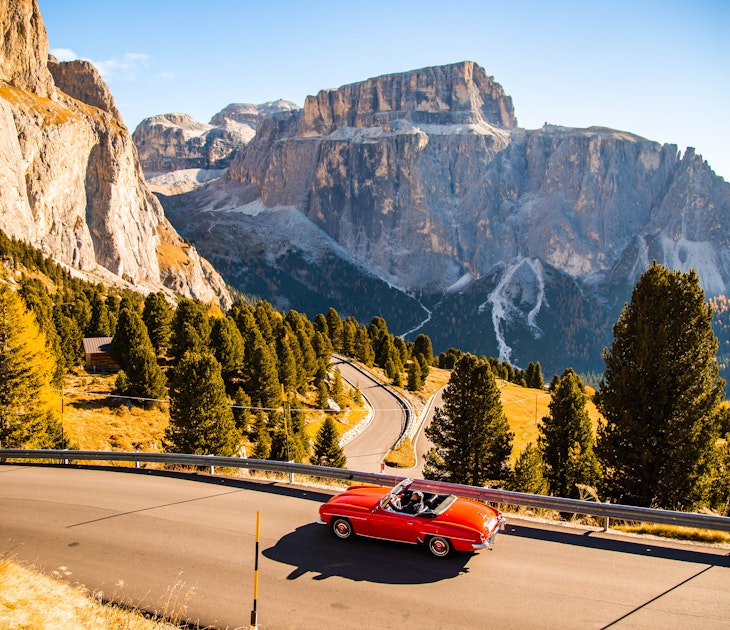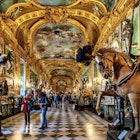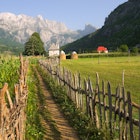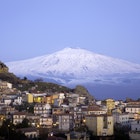
Sicily vs Sardinia: which Italian island should you escape to?



The secluded beaches of Sardinia, or the historic monuments of Sicily? Our writers will help you decide © iStock
Some countries are blessed. And then there’s Italy, which is endowed with not one but two huge island regions in the Mediterranean.
Both filled with churches, vineyards, churches and sites testifying to millennia of history, Sicily and Sardinia are nonetheless truly distinct – and truly wonderful. Having trouble picking between the two? We’ve asked two partisans to go to the mat for their picks.
Sicily: savor its sumptuous soul
A Lonely Planet Italy expert for more than a decade, Nicola Williams lives a scenic flit through the Mont Blanc Tunnel from il bel paese. Her favorite Sicilian journeys are those where time slowly stills.
- placement: fullWidth
- path: articles/in-content-top
- possible size: [970, 250], [970, 90], [728, 90], [300, 250], [320, 50], [1, 1],
- targeting:
{ "url": "sicily-vs-sardinia" }
Yes, certain spots in Sicily have all the dazzling beauty and million-dollar glamour of a Hollywood movie star. (Knowing the island inside out as I do, it’s honestly a no-brainer why The White Lotus team decamped here to film the second season of HBO’s breakout hit.) But it is in fact Sicily’s gutsy soul, ravishing virgin landscapes and cultural treasures that make it so utterly captivating and irresistible as a holiday destination. I challenge anyone to step foot on Sicilian soil and not leave with a burning desire to return.

My first Sicilian escapade was with my family moons ago. We sailed into the small but busy port of Trapani one April and spent two gloriously warm weeks roaming the less-explored west of the island: learning to harvest salt along the Via del Sal, hiking mule tracks in the remote Madonie mountains, running wild through meadows of sun-yellow fennel around Segesta’s majestic Greek-temple ruins. The fact we didn’t even make it to uber-chic Isola Bella, glitzy Taormina or baroque beauty Noto (all now of White Lotus fame) was completely incidental. Sicily had me hooked.
I’ve spent countless weeks since digging deep into Sicily’s green soul: again with the kids; solo; and in the depths of winter, when snow caps Mt Etna and blood-red pomegranates ripen. During last August’s apocalyptic heatwave, Sicily’s paradise-like beaches were my second home. If you think it’s all dreamy sweeps of soft golden sand polka-dotted with parasols and hawkers roasting ears of corn to order, think again. Seaside Cefalù on the Tyrrhenian Coast is a shameless heartthrob, with its cinematic sands and honied old town showcasing one of Sicily’s greatest Arab-Norman architectural masterpieces.
Snorkeling off sun-scorched rocks with locals on Capo Cefalù, uncovering tiny pebble coves cradling emerald waters in the Riserva Naturale dello Zingaro, and clambering across wave-splashed rocks to Capo Milazzo’s natural piscina (swimming pool) in the sea are all equally awe-inspiring. And if it’s high-octane natural beauty and solitude you’re after, simply set your compass south to the wild and windswept seashore of the WWF-protected Riserva Naturale di Torre Salsa on Sicily’s Mediterranean coast.

Then, of course, there’s Sicily’s sublime islands: the Egadi and Aeolian archipelagos. Volcano aficionados naturally gravitate to “mainland” Etna – the Wine Train is a brilliant chance for families and less-active travelers to eyeball the explosive peak close up. But it’s the spectacular nightly fireworks on back-to-basics Stromboli that’s the sneaky heart-stealer. Whether you’re hiking up its volcano at sunset, flopping on a black beach or watching a rooftop movie beneath the stars at 1950s Hotel Villaggio Stromboli, you feel the car-free island’s primeval force sizzling off every last volcanic rock and grain of black sand. I love breakfast and aperitivo at buzzy Il Canneto and raw fish at after-dark hotspot L’Angolo del Pesce. A half-hour hydrofoil ride away, fashionista Panarea is the manicured yin to Stromboli’s rough-cut yang. Drink in the insanely chic vibe over cocktails – Italianate shades firmly on – at Bridge Ammare overlooking Baia Zimmari.
- placement: fullWidth
- path: articles/in-content-middle
- possible size: [970, 250], [970, 90], [728, 90], [300, 250], [320, 50], [1, 1],
- targeting:
{ "url": "sicily-vs-sardinia" }
Sorry, Sardinia: you simply can’t compete with Sicily’s Herculean cultural heritage. Outside of Greece, nowhere else in Europe summons the ancient world with such drama. Greek temple ruins at Selinunte, Segesta and Agrigento’s Valley of the Temples are unbelievably well preserved. But watching a classical tragedy unfold on stage at Syracuse’s ancient theater really is something else entirely. Ditto for the island’s cache of baroque towns and spellbinding collection of Roman, Byzantine and Arab-Norman mosaics (you only need to visit Unesco-listed Villa Romana del Casale or Cattedrale di Monreale to get the picture).
I’ve saved waxing lyrical about Sicily’s unpretentious grassroots cuisine until last in case you need to set off for lunch. In all honesty, it’s hard to know where to begin: a beefy spleen bun from a pushcart at one of Palermo’s intoxicating, souk-like markets, or a paper cone of battered frittura mista (deep-fried seafood) from one of Catania’s traditional fish vendors? Mulberry granita and a sweet brioche bun by the sea at Da Alfredo’s on Salina? Lobster soup and couscous-esque frascatole at Trattoria Il Veliero on Marettimo? Michelin-starred gastronomy in caves in Ragusa Ibla or a Renaissance art studio in Palermo? Decadent cannoli and dolci (cakes) to simply die for all over the island?
Eat your heart out, Sardinia.
Sardinia: into the wild unknown
Kerry Walker has made Sardinia her spiritual home in the Mediterranean over the past decade and has co-authored the Lonely Planet Sardinia and Italy guidebooks.
Sicily has hogged the limelight for long enough. The island is so ridiculously popular and so frequently splashed across screens – from the family drama of The Godfather to the secrets of the hideously super-rich in The White Lotus – you feel you know it before you even arrive. And while Sicily’s allure is undeniable, it can suffer from the mass tourism curse. Come summer, it’s simply swamped.
And Sardinia? What do you know about this island? My guess is not a lot – unless you happen to have been there. You might have heard about the jet-set haven of the Costa Smeralda, where celebs with mega-yachts escape the paparazzi – but other than that, niente. Because while Sicily has been busy blowing its own trumpet (and its volcanic top), its less showy cousin is happy to stay in the sidelines and whisper quietly about its charms.
But my, what charms! I’ve traveled pretty much every inch of Sardinia over the past decade, and I swear this is the island of your wildest Mediterranean dreams. So put Sicily out of your mind for a minute, and follow me.
Let’s start with the beaches, shall we? Sardinia has some of the most insanely beautiful spiaggie you’ll find without stepping foot off European shores. They’re often likened to the Caribbean, but why imagine yourself anywhere else? Time and again I’m blown away by the east coast Golfo di Orosei’s exquisite bays, many of which can only be reached on foot or by boat. Here, ragged limestone cliffs dive to flour-white sands and a sea so turquoise it looks Photoshopped.
- placement: native
- path: articles/in-content-native
- possible size: [f, l],
- targeting:
{ "url": "sicily-vs-sardinia" }
On the north coast, La Maddalena’s pink granite islands hide sublime coves and ruffled azure waters. Then there is La Cinta, with bleached sands sloping into cerulean seas and a lagoon fizzing with flamingos, and the Costa Smeralda’s astonishing Spiaggia del Principe. Heading west reveals the great dunes and waves of the Costa Verde, while south-coast Is Arutas sparkles with an arc of frost-white quartz sand. Choosing a favorite is impossible. I swear.

But the beaches are just tip-of-the-iceberg stuff. Sure, Sicily has Mt Etna – yet Sardinia is just as wild, mountainous and ripe for adventure. Spring brings the magic touch, with wildflowers lighting up the slopes and coast. Go then and you’ll get the island’s trails largely to your lucky self. Great hiking is plentiful, but the uphill scramble through a lush, silent valley to the mysterious Bronze Age ruins of Tiscali, and the trek to Gola Su Gorropu, where 400m(1312ft)-high walls of sheer limestone rise above a boulder-strewn gorge that’s often billed “Europe’s Grand Canyon,” are unmissable. Italy’s toughest trek? Heading off the radar on the week-long Selvaggio Blu trek on Golfo di Orosei is epic, involving climbing, abseiling, route finding and camping by a starlit sea as if you were the last person left on earth.
If you prefer action by the water, it’s all here: from some of Europe’s best DWS (deep-water soloing) to windsurfing; surfing; kitesurfing; diving the coral-filled, cathedral-like depths of the Nereo Cave, the largest underwater grotto in the Mediterranean; or kayaking to your own private cove on the island’s east coast.
Sicily’s cities get all the fuss, but Sardinia can rival them for culture – and they’re generally less crowded and chaotic. Take Alghero, with its honey-colored sea walls, Gothic palazzi, cafe-lined piazzas and palpable Spanish vibe, for instance. And I love heading up to the rock-hugging ramparts of Cagliari’s Il Castello district for a sundowner at dusk, when the sky pinkens, the Pisan towers glow gold and locals head out for an evening passeggiata (stroll) among medieval citadel walls.
Historically, you might think Sicily has the ace with its Greek temples and Byzantine mosaics, but Sardinia has many surprises up its sleeves. Namely 7000 megalithic nuraghi, Bronze and Iron Age towers and settlements that include tombe dei giganti (“giant's grave” tombs), pozzi sacri (sacred wells) and domus de janas (fairy houses) straight out of a kids’ story. One is a Unesco World Heritage site (Nuraghe Su Nuraxi) – though the real thrill of prehistory here is that you just happen upon it, as if a 4000-year-old temple plonked in a farmer’s field were no big deal.

Ah, but what about the food, you say? Again, you might think Sicily had the edge, but some of my most memorable meals have been on Sardinia, an island that embraced slow food long before it became a trend. The pasta here is sensational: sun-dried, couscous-like fregola; shell-shaped malloreddus swimming in rich tomato, garlic, basil and saffron sauce; and ravioli-like culurgiones, stuffed with pecorino and mint. And the seafood? Divine. Try sea urchins and lobster from Alghero, giant gamberi rossi (red prawns) and Cabras bottarga (mullet roe). Agriturismi (farmstays) dish up spectacular feasts: antipasti, pasta, porceddu (suckling pig slow-roasted over juniper or myrtle) and seadas, honey-drenched fritters filled with ricotta and lemon zest that are – dare I say it – even more delicious than cannoli.
Good news: you can drink the local Cannonau wine with a clean conscience. The full-bodied, antioxidant-packed red is one of the reasons the island’s mountainous interior is one of the world’s five “blue zones” – places of extraordinary longevity, with incredibly high percentages of centenarians. No wonder: there is so much here to live for.
- placement: fullWidth
- path: articles/bottom
- possible size: [970, 250], [970, 90], [728, 90], [300, 250], [320, 50], [1, 1],
- targeting:
{ "url": "sicily-vs-sardinia" }
Explore related stories









